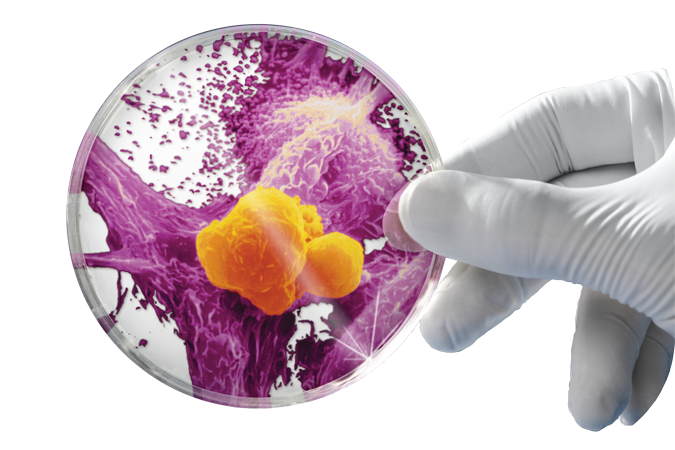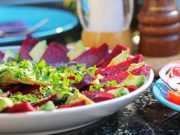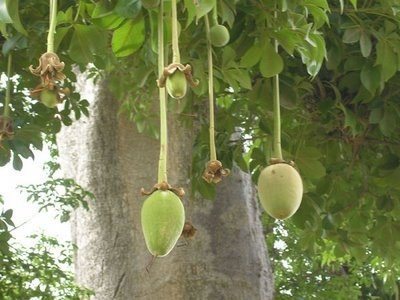The baobab tree, Adansonia digitata, is a member of the Bombacaceae family. This deciduous tree was originally located in South Africa, Botswana, Namibia, Mozambique and Zimbabwe but can be found in most countries within the African continent. This tree is also common in America, India, Sri Lanka, Malaysia, China, Jamaica and Holland.
The baobab tree has many names including the monkey bread tree, the cream of tartar tree, and the “upside down tree”. This last reference is due to the striking silhouette that the baobab tree forms at sunset which gives the appearance of the tree being uprooted and stood on end.
Its flesh is crammed full of vitamin C, calcium and antioxidants – it packs a nutrition punch that makes so-called « super-fruits ». It’s rare for calcium to be found in large quantities in fruit and vegetables, and even kale does not have this amount. It’s a fruit with extraordinarily high levels of the key nutrients. Hence its popularity in parts of Africa among pregnant and breastfeeding women.
Interesting facs about Baobab:
The adansonia digitata, which is the only baobab species in Africa, provides many forms of nourishment. Baobam grows in Southern, central, western and north-eastern Africa, on savannah; National tree of Madagascar, where there are seven species;Western Australia, where one tree was used to imprison Aborigines. The trunk is hollow and stores water, and is often home to bats and snakes, and even humans. A district commissioner in Zambia once set up his office inside, and a tree still standing in Western Australia was used to imprison Aboriginal convicts in the 1890s.
Livingstone, who famously carved his name on a number of trees, said it was likely that these trees were grown at the time of the last Great Flood, 4,000 years ago.
The tree bark is very unusual in that it regenerates itself. In Zambia, some baobab trees continue to grow with spears through their trunks. The Ngoni people believed the enemy Bisa tribe could turn themselves into baobabs, so speared some of the trees.
The bark is stewed to wash newborn babies to give them strength, but some people in Zambia believe eating baobab attracts crocodiles and therefore fisherman may avoid it.
Baobab nutrition value:
The hard shells of the fruit are cracked open and the powdery fruit pulp is separated from the seeds and shell before use. The resulting free flowing creamy white powder, melts in the mouth when sampled and has a unique pleasant flavour with a mild slightly acidic after taste which can easily be masked with sweeteners or other flavourings for incorporation into drink products.
Airan and Desai (1954) first highlighted the presence of organic acids in the baobab fruit pulp. These included citric, tartaric, malic, succinic, and ascorbic acid. A later report from Nour et al (1980), confirmed the observations of Airan and Desai when they showed that the pulp contained ascorbic acid, tartaric acid, mainly water soluble pectins, and the elements of iron and calcium.
Nutritional analysis of baobab fruit pulp has shown that the fruit is an excellent source of pectins, calcium, vitamin C and iron. Vitamin C content of baobab fruit pulp has been compared with orangesby Manfredini et al (2002), and shown to be at least at least three times higher (150-499 mg/100g vs 46mg/100g). The current EC RDA value is given as 60 mg/day and so 10g of fruit pulp would give at least 25% the recommended daily amount of ascorbic acid.
The baobab fruit pulp contains a high level of pectins, and contain up to 56% water soluble pectins.Pectins help to reduce the amount of “bad” cholesterol, and withdraw the radioactive elements from the body.
Baobab is:
-More than 10 times the antioxidant level of oranges and six times more vitamin C;
-More than twice the calcium level of milk;
-Soluble fibre in fruit pulp has pre-biotic qualities and stimulates good bacteria in gut;
-High in potassium, important for brain, nerve and muscle function;
-And phosphorus, which helps bones.
Traditional food uses:
The pulp of the baobab fruit is reported to have numerous uses by the indigenous people of Africa. Bosch et al (2004) reported that the fruit is eaten as a sweet and used to make ice-cream. In Sudan, a refreshing drink called ‘gubdi’ is made from the fruit pulp and cold water to preserve the vitamins (Bosch et al, 2004). Amongst the Hausi farmers, the baobab fruit juice mixture is a popular drink and is available during the hot times of the year (Nicol, 1957).
The baobab fruit pulp is reported to be used in cooking, the dried pulp can be used in baking as alternative for cream of tartar (Bosch et al, 2004). Diop et al (1988) reported that the pulp was richin calcium and this was the main reason that the baobab was largely consumed by pregnant women and children in Senegal. A study of pregnant women in Gambia, by Prentice et al (1993), reported that eating the fruit pulp in season (December to April) without the seeds once a day, contributed 30 mg/day calcium to the diet.
Medicine use of baobab fruit:
All parts of the baobab tree are reported to have medicinal properties according to traditional folklore (Watt and Breyer-Brandwijk 1962). Of particular interest is the use of baobab fruit and seeds to treat dysentery as reported by Watt/Breyer-Brandwijk (1962). Baobab fruit is reported to have febrifuge (antipyretic) properties in traditional medicine. Ramadan et al, (1994) showed that whilst baobab fruit pulp may lower elevated body temperature, normal body temperature is not affected.
Baobab for Inflammation
Baobab contains numerous healing properties and one of its vital functions is its anti-inflammatory property. Also, studies show Baobab has a high level of content for sterols, saponins and triterpenes, which are natural chemicals found in plants responsible for enhancing the immune system and reducing inflammation.
The saponins found in Baobab react favorably to the good bacteria found in the intestines by enhancing their growth and getting rid of toxins and wastes from the colon. By eliminating these toxins and improving nutrient absorption, the body’s natural immune system and antibodies can efficiently fight inflammation. In addition, improving immune factors can minimize the risk of progressive coronary disease.
On the other hand, triterpenes, which is a natural compound abundant in Baobab, has important anti-inflammatory functions. Triterpenes is another reason why it is recommended to take Baobab for inflammation. This plant compound is proven to improve allergies, tumors and inflammation as well as strengthen digestive system and the stomach. It often exhibits bioactivity such as antiviral, antibacterial and antifungal effects. This substance also promotes normal blood pressure and balance in blood lipids.
When taking Baobab for inflammation, the leaves are dried and powdered and drunk daily to relieve inflammation of the intestine. The seeds contain O-acethyethanolamine, which is also believed to act against inflammation and can be powdered to treat gingivitis. In Malawi, the root decoction can be used to treat a sore throat. In West Africa, the Baobab bark decoction is used to wash the eyes with conjunctivitis and the lalo for compress. In Senegal, enteritis is treated by drinking the fruit pulp with water or decoction of powdered seeds. Throughout Africa, common body inflammations are treated by applying lalo compress or powdered Baobab leaves, fumigating using the leaves, warm paste using boiled leaves, or compress made from crushed seeds.
Baobab for Fever
One of the most common herbal plants in Africa is Baobab, which is also an anti-pyretic, febrifuge and diaphoretic. Taking Baobab for fever has long been practiced in Africa and is still widely used until today.
The bark of Baobab is used as a diaphoretic based on local traditional medicine; it is used by placing in steam baths or drunk to treat high-grade fever. The leaves are also diaphoretic, yet it is also used as anti-diaphoretic to cure excessive sweating. The botanist Michael Adanson also used Baobab leaves to continually free himself from fever and diarrhea during his stay in Africa. By boiling Baobab leaves, he drank half a liter of Baobab tea daily, every morning and evening. Until today, the leaf decoction is still commonly used in Africa to treat malaria. From Senegal to Kenya, the locals still take Baobab for fever. By boiling the fruit pulp and seed, the Baobao pulp tea is drunk as febrifuge. The unripe fruit is cooked into a candy with millet, locally called Bengal, and eaten as febrifuge and laxative. In the same way, in Mali, ½ liter of Baobab decoction that contains 30 grams of bark is also used as treatment for fever. In Kenya and Tanzania, the bark decoction is used in steam baths to treat infants with high fever. Baobab is also popular in Ayurvedic medicine. Based on this local medicine tradition, the Baobab bark, leaf decoction and the fruit pulp mixed with water are drunk to reduce fever and night sweats as well as tuberculosis.
In terms of its analgesic activity, it produced analgesic effects similar to Aspirin (Acetysalicylic acid), with a longer reaction time. In addition, the same goes for its anti-pyretic effect, which is comparable to the standard dose of Aspirin on hyperthermic rats. These effects may be caused by saponins, sterol and triterpenes present in Baobab extract.
Baobab for Vitamin C Deficiency
Vitamin C deficiency is a nutritional disorder that comes from inadequate intake of vitamin C. This disease can lead to gingivitis, dry and scaly skin, anemia, damaged hair, weak tooth enamel, painful joints and slowed metabolism leading to weight gain. The severe form of vitamin C deficiency is called scurvy, which when left untreated could cause eventual death. Certainly, Vitamin C plays a vital role in protecting our cells and keeping our body healthy. It also aids in the absorption of iron and other essential minerals from food. Vitamin C promotes the production of collagen, an essential protein necessary to maintain healthy skin, teeth, gums, bones, joints, linings, cartilage and blood vessels. Baobab contains much higher levels of Vitamin C compared to other fruits known for being Vitamin C-rich, including the kiwi, orange, grapefruit and strawberry. Studies show Baobab fruit to have an exceptional Vitamin C content at 150 – 499mg/100g, which is more than six times higher than an orange, which only contains 53mg/100g. This is the reason why it is good to include Baobab in your daily diet.
Furthermore, taking Baobab for Vitamin C deficiency can help in enhancing antioxidant levels of the body. Because of its high level of Vitamin C content, its antioxidant capability is considered by many experts, particularly when treating other diseases besides Vitamin C deficiency. This is the reason why Baobab fruit pulp is promoted as a milk substitute for babies in many countries in Africa. It has also been reported that Arab sailors consumed the fruit to prevent scurvy.
There are varied ways to prepare Baobab for Vitamin C deficiency treatment. The most common is by consuming the fruit pulp, which can treat scorbutic symptoms. It can also be boiled with water and sugar and made as a fruit jam that can be added to the diet for several weeks. The leaves are also rich in Vitamin C and are commonly dried and powdered. Its acid pith is a source of ascorbic acid and can be ground and made into a refreshing drink. Having Baobab for Vitamin C deficiency is an effective and inexpensive therapeutic management to treat this type of nutritional disorder. Moreover, its vitamin A, antioxidants and essential minerals content are all very interesting, which makes the fruit highly recommended in promoting better health and proper body functioning.
Medicinal uses of Baobab leaves:
The fresh leaves contain high amounts of Vitamin C as well as other nutritional elements such as alpha and beta carotenes, rhamnose, uronic acids, tannins, potassium, calcium, catechins, tartrate, glutamic acid, mucilage and other sugars.
Therapeutically, the Baobab leaves have several benefits and are packed with medicinal properties to treat common illnesses. Baobab acts as an expectorant for cough, diaphoretic and anti-pyretic. It is also an astringent and relieves excessive perspiration. Also, the leaves can treat certain forms of allergy with their anti-histamine and hyposensitive properties. They can treat asthma, fatigue, inflammations, insect bites, kidney and gallbladder diseases and dracunculiasis – a form of parasitic worm infection that only occurs in Africa. Powdered Baobab leaf poultices are also used to treat sores.
Drying the leaves is a common practice among the people in Africa. They are typically sundried, powdered and cooked daily for family sauce. Application of proper drying method is essential to preserve its Vitamin A level. The Vitamin A content of Baobab leaves often depends on the different tree type, the drying method and the processing method. When drying leaves, it is recommended to apply shade drying to double its ProVitamin A content rather than direct sun drying. The Vitamin A is also boosted by choosing ideal small leaves. In Mali, the leaves are harvested greatly during the end of the rainy season (late October) or before the leaves fall out. The leaves are a staple ingredient in cooking in Africa. It is locally known as kuka and commonly used in making kuka soup. The leaves are used throughout the continent in Africa as leaf vegetable.
Sweets from baobab fruit:
The fruit is mixed with water and drunk as lemonade, the seeds are roasted and made into coffee, the leaves can be made into spinach and the children suck the seeds. Baobab – jam, which is made from the pulp, is more appetising. It looks like dark honey. The taste is tart – akin to lemon curd – and the texture gritty like a tangy pear.


























